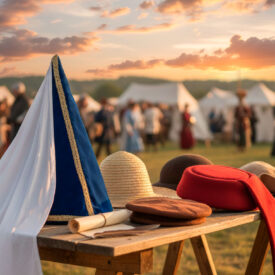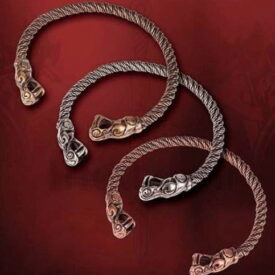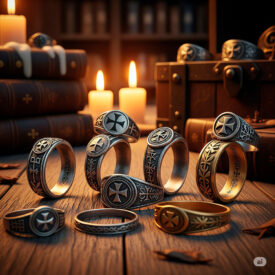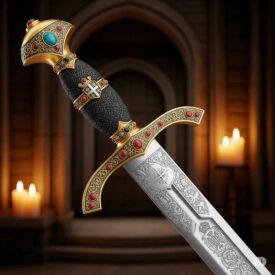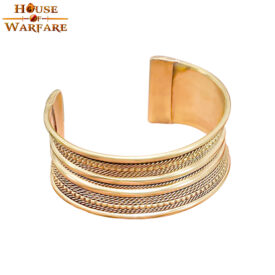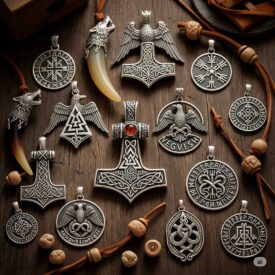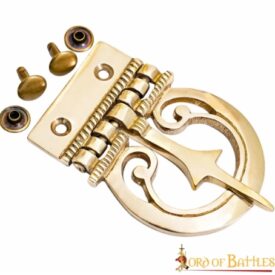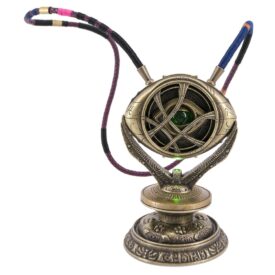What ancestral object has transcended millennia to become an emblem of power and heritage, adored in both Norse myths and current fashion? If you thought of Thor’s hammer, Mjölnir, you were right. This pendant, much more than a simple ornament, is a beacon of the strength and spirit of an era forged in sagas and mythical battles. Discover in this article the deep history, symbolism, and relevance that Viking pendants with Thor’s hammer have had throughout the centuries, from battlefields to contemporary runways.
Mjölnir: Evolution of the Symbol and its Use during the Viking Age
Thor’s hammer pendants (Mjölnir) emerged and spread within the framework of the Viking Age; their presence in jewelry and rituals reflects both artistic changes and cultural responses to Christianization. Below is an organized chronology of the main milestones and the meaning associated with the amulet.
| Period or Century | Event or Context |
|---|---|
| General Context: Viking Goldsmithing | |
| c. 8th to 12th Centuries | Viking goldsmithing and its craftsmanship, inspired by mythical beliefs (including Mjölnir), developed throughout this period. |
| c. 800 – 900 AD | The earliest known representation of Mjölnir, carved into the Snoldelev stone, is recorded. |
| 8th to 11th Centuries (Viking Age) | Period of Viking expansion in Europe. Norse symbols, including Mjölnir, appear in jewelry and funerary artifacts. |
| Viking Artistic Styles Related to Pendants | |
| Broa‑Oseberg Style | Second half of the 8th century to mid-9th century. Forms part of the early decorative repertoires where motifs that would influence the pieces appear. |
| Borre Style | First half of the 9th century to second half of the 10th century. Characteristic ornamentation in metal pieces and pendants. |
| Ringerike Style | c. 1000–1050. New ornamental alphabet and stylistic variants in jewelry, including the hammer. |
| Urnes Style | Second half of the 11th century to first half of the 12th century. Last fully developed pre-Christian stylistic variants. |
| Late 10th and 11th Centuries | Rise in the popularity of Mjölnir amulets. Hammers are manufactured alongside crosses as a way to resist the pressure of Christian conversion; in this period, more Hammer amulets appear than any other type. |
| 12th Century | Mjölnir documented in pendants and amulets and cited as an integral part of some funerary rites, especially for those who died at sea. |
| Meaning and Use of Mjölnir Pendants | |
| Protection and Strength | Mjölnir, Thor’s weapon, was worn to place oneself under the god’s protection and transfer strength and vigor; its name alludes to “that which crushes/grinds.” |
| Symbol of Order | Represented the preservation of divine order against chaos (the giants) and the defense of Asgard. |
| Fertility and Consecration | Used in rituals of blessing and consecration (e.g., in marriages), with protective and fertility functions. |
| Good Luck | Also interpreted as an amulet of good fortune within Norse culture. |
| Cultural Resistance | Its use increased in the late 10th and 11th centuries as a symbol of pagan identity against Christianization; many hammers were manufactured in parallel with Christian crosses. |
| Funerary and Social Context | Although associated with warrior attributes, hammers are frequently found in female graves, indicating a broader ritual and fertility meaning. Common materials: silver and bronze (also gold and iron). Some bear engraved runes to invoke protection or blessings. |
| Associated Runes | Mjölnir is associated with the Uruz rune (strength and fertility). The Thurisaz rune is also linked to Thor or the hammer itself (Mjöllnir). |
- General Context: Viking Goldsmithing
-
- c. 8th to 12th Centuries: Viking goldsmithing developed, inspired by mythical beliefs.
- Viking Artistic Styles Related to Pendants
-
- Broa‑Oseberg Style: Second half of the 8th century to mid-9th century. Early motifs influencing the pieces.
- Borre Style: First half of the 9th century to second half of the 10th century. Ornamentation in metal pieces and pendants.
- Ringerike Style: c. 1000–1050. New ornamental alphabet and stylistic variants in jewelry.
- Urnes Style: Second half of the 11th century to first half of the 12th century. Last pre-Christian stylistic variants.
- Meaning and Use of Mjölnir Pendants
-
- Protection and Strength: Worn for Thor’s protection and to transfer strength.
- Symbol of Order: Represented the preservation of divine order.
- Fertility and Consecration: Used in blessing and fertility rituals.
- Good Luck: Amulet of good fortune.
- Cultural Resistance: Its use increased against Christianization.
- Funerary and Social Context: Found in female graves, indicating a broader ritual meaning.
- Associated Runes: Mjölnir is associated with the Uruz and Thurisaz runes.
Mjölnir: A Symbol of Ancestral Power
Thor’s hammer, Mjölnir, is undoubtedly the quintessential Viking symbol, an emblem of protection and strength that has endured through the centuries. Forged by the legendary dwarf smiths Brokkr and Sindri, every blow of Mjölnir resonated with the power of Thor, the god of thunder, who bravely used it to protect Asgard and humanity from giants and the forces of chaos.
Mythological and Symbolic Meaning in Depth
Mjölnir is not just a weapon; it is a multifaceted amulet whose symbolism extends far beyond battle. Let’s delve into the universe of its meaning:
| Main Symbolic Function | Detail and Reference |
|---|---|
| Protection | Thor was the protector of humans against giants. The amulet was worn to obtain the god’s protection and transfer his power to the wearer. It is a symbol of protection, strength, and the power of the gods. |
| Strength and Power | Symbolizes strength and vigor. Represents strength, protection, and power. The name Mjölnir translates as “that which crushes” or “that which grinds.” It bestows the strength to repel evil beings and protect the clan from harm. It is the protector of order (Asgard) against chaos (giants). |
| Fertility and Consecration | Thor is also a god of weather and fertility. The hammer was used as an emblem of fertility to sanctify weddings and marital homes, often placed on the bride’s lap or on the bridal bed as a marriage blessing. Furthermore, Mjölnir can give life to dead things and beings and bless events. |
| Order and Luck | Symbolizes the maintenance of divine order and the warding off of chaos. It is considered a widely recognized symbol of good luck. It was used in ceremonies (birth, wedding, burials, field blessings) with the character of keeping the world in its place. |
| Amulet of Transition | During the period of resistance to Christianization (late 10th and 11th centuries), smiths created Mjölnir amulets alongside crosses. It became an integral part of funerary rites for those who died at sea, showing that the wearer would not be lost at sea, but would return safe and sound. |
| Worthy | Mjölnir could only be wielded by those worthy of it, as it responded only to those with a pure heart and great courage. |
- Main Symbolic Function: Protection
-
- Detail: Thor was the protector of humans against giants. The amulet was worn to obtain the god’s protection and transfer his power to the wearer. It is a symbol of protection, strength, and the power of the gods.
- Main Symbolic Function: Strength and Power
-
- Detail: Symbolizes strength and vigor. Represents strength, protection, and power. The name Mjölnir translates as “that which crushes” or “that which grinds.” It bestows the strength to repel evil beings and protect the clan from harm. It is the protector of order (Asgard) against chaos (giants).
- Main Symbolic Function: Fertility and Consecration
-
- Detail: Thor is also a god of weather and fertility. The hammer was used as an emblem of fertility to sanctify weddings and marital homes, often placed on the bride’s lap or on the bridal bed as a marriage blessing. Furthermore, Mjölnir can give life to dead things and beings and bless events.
- Main Symbolic Function: Order and Luck
-
- Detail: Symbolizes the maintenance of divine order and the warding off of chaos. It is considered a widely recognized symbol of good luck. It was used in ceremonies (birth, wedding, burials, field blessings) with the character of keeping the world in its place.
- Main Symbolic Function: Amulet of Transition
-
- Detail: During the period of resistance to Christianization (late 10th and 11th centuries), smiths created Mjölnir amulets alongside crosses. It became an integral part of funerary rites for those who died at sea, showing that the wearer would not be lost at sea, but would return safe and sound.
- Main Symbolic Function: Worthy
-
- Detail: Mjölnir could only be wielded by those worthy of it, as it responded only to those with a pure heart and great courage.
Mjölnir and the Viking Man: An Unbreakable Bond
 Although Mjölnir held vast significance for all of Viking society, its relationship with the men of the era was particularly meaningful. This powerful amulet was primarily worn by them, embodying the essence of virility and warrior strength. The Uruz rune, associated with Thor, translates as “Aurochs” (the wild ox), symbolizing physical, mental strength, and masculine virility. Likewise, the Thurisaz rune, which represents Mjölnir itself, evokes human physical strength, including passion and courage in combat. Mjölnir pendants encouraged warriors to embrace their “inner warrior” and to courageously defend their values and beliefs.
Although Mjölnir held vast significance for all of Viking society, its relationship with the men of the era was particularly meaningful. This powerful amulet was primarily worn by them, embodying the essence of virility and warrior strength. The Uruz rune, associated with Thor, translates as “Aurochs” (the wild ox), symbolizing physical, mental strength, and masculine virility. Likewise, the Thurisaz rune, which represents Mjölnir itself, evokes human physical strength, including passion and courage in combat. Mjölnir pendants encouraged warriors to embrace their “inner warrior” and to courageously defend their values and beliefs.
The Intricate Duality of Mjölnir: Only for Men?
In the fascinating world of Viking archaeology, the truth is often more complex than a first glance might suggest. While written sources and popular tradition strongly link Mjölnir to masculinity and Thor’s power, archaeological findings reveal a more nuanced picture. Surprisingly, Thor’s hammer pendants have been found more frequently in women’s graves than in men’s. This revelation suggests that Mjölnir transcended mere male warrior symbolism. It could have been a powerful fertility talisman, a protector for health during pregnancy, or a symbol of consecration and good luck for the entire family, regardless of gender. This duality underscores the richness and depth of Viking symbolism, where strength was not exclusive to battle, but also manifested in the creation and protection of life itself.
The Return of Mjölnir: Modern Trends and Cultural Connection
Currently, the fascination with Norse culture and its profound symbols has resurfaced with undeniable force, largely thanks to the influence of popular culture. Films, series, and comics have brought Thor and his hammer Mjölnir to the forefront of collective consciousness. This resurgence has turned Mjölnir pendants into a fashion icon, not only as a nod to Viking aesthetics but as a personal declaration of strength, protection, and connection to an ancestral cultural heritage.
Viking pendants for men, far from being simple jewelry, represent a tangible connection to the past, a reminder of the indomitable spirit of the Norse people and their deep respect for the gods. Traditionally crafted from silver or bronze, and occasionally with the luxury of gold or the robustness of iron, these amulets are often enhanced with runes like Uruz, which promise additional protection and blessings, or Thurisaz, which invokes strength. Wearing a Mjölnir today is to carry a piece of history, a declaration of identity, and a link to the values of strength, protection, and honor that resonated in Viking hearts.
Resolve your doubts about the Mjölnir hammer and Viking iconography
What is the story behind the Mjölnir hammer?
The Mjölnir hammer, in Norse mythology, is the powerful weapon of the god Thor, forged by the dwarfs Sindri and Brokkr as a result of a challenge wagered by Loki. Although its handle ended up shorter than intended due to Loki’s interference, Mjölnir is a powerful weapon that can crush mountains, always returns to Thor’s hand after being thrown, and symbolizes protection, strength, and ritual consecration.
In addition to its origin, there are stories about how the hammer was stolen by the giant Thrym, who demanded the hand of the goddess Freya in exchange for its return. To recover it, Thor disguised himself and, at the fake wedding, recovered Mjölnir and annihilated the giants, reaffirming his role as defender of gods and humans against the forces of chaos.
What other Viking symbols are popular today?
Among the popular Viking symbols today, several stand out that have roots in Norse mythology:
- Valknut: Known as the “knot of the fallen,” this symbol is very mysterious and symbolizes death, rebirth, and the connection between the living and the dead. It is associated with Odin and warriors entering Valhalla.
- Vegvisir: Also called the “Viking compass,” it is believed to guide its wearer through challenging situations, such as storms or dangerous journeys. It protects and directs the wearer.
- Aegishjalmur: Known as the “helm of awe,” it is a symbol of protection. It is believed to grant strength and courage to the wearer, making them invincible.
- Mjölnir: It is Thor’s hammer, representing protection and power. It is one of the most recognizable symbols of Norse mythology.
- Troll Cross: Originating in Sweden, it is used as an amulet to protect against trolls and dark magic. Today, it is also associated with luck and protection.
- Runes: Part of the ancient Norse alphabet, each rune has a specific meaning and is frequently used in tattoos and talismans.
- Dragons: Powerful beings in Norse mythology, such as Jörmungandr, symbolize strength and resilience. They are popular in tattoos and art.
How is Thor’s hammer related to protection in Viking culture?
In Viking culture, Thor’s hammer, known as Mjölnir, is deeply related to protection. It was a widely used symbol to defend against dangers, both natural and supernatural. Thor, the god of thunder, was revered as the protector of humans against giants, and his hammer was worn as an amulet to invoke this divine protection.
In addition to its role as a weapon, Mjölnir was also used in ceremonies to consecrate and bless people and places. In matrimonial contexts, a Thor’s hammer was placed on the bride’s lap or on the bridal bed to ensure union and grant protection to the couple.
Likewise, Thor’s hammer symbolized the balance between destruction and creation, reflecting the god’s ability to control weather and fertility. This meant that, although Mjölnir was a powerful weapon, it also represented the protection of life and nature.
In the Viking Age, wearing a Mjölnir amulet was a way to show loyalty to the Norse religion and to ask for protection during a period of transition to Christianity. Therefore, Thor’s hammer was an integral symbol of protection and strength in Viking culture.
What materials are commonly used to make Viking pendants?
The most common materials used to make historical Viking pendants were silver, bronze, iron, and, to a lesser extent, gold. Silver stood out for its relative abundance and was the preferred material for most jewelry, while gold, much scarcer, was reserved for elites and symbols of social status. Bronze and iron were used in more accessible pieces for the general population. Additionally, other materials such as amber, animal bones, pewter, and, in some cases, stones or resin were occasionally used. In modern Viking jewelry, stainless steel is also common due to its durability and lower cost.
What other Viking pendants, besides Thor’s hammer, have specific meanings?
In addition to Thor’s hammer, there are several Viking pendants that have specific meanings:
- Valknut: This symbol is associated with Odin and represents the cycle of life and death, as well as the warrior spirit. It is believed that the intertwined triangles signify the transition between life and death and the honor of dying in battle.
- Yggdrasil (Tree of Life): This pendant symbolizes the structure of the Norse universe, connecting heaven, earth, and the underworld. It represents connection to nature and stability.
- Jörmungandr (Midgard Serpent): This mythological sea dragon is a symbol of power and resilience, associated with the struggle between chaos and order.
- Vegvisir, the Viking Compass: This symbol is known for offering guidance and protection in difficult times, helping to find the right path in confusing situations.
- Symbolic Animals: Animals such as the wolf, bear, and raven are associated with different qualities, such as loyalty, strength, and wisdom, respectively. These animals were used in jewelry to represent these virtues.
These pendants are not only ornaments; they also represent connections to Norse mythology and culture.
VIEW MORE VIKING PENDANTS | VIEW CELTIC PENDANTS

